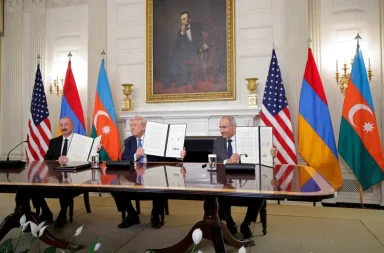by David Bishop
The government of Azerbaijan has officially announced its planned military budget for 2026, approving a plan to increase expenditures to 8.17 billion Azerbaijani Manat. This is the equivalent of 1.83 trillion Armenian Dram, or about 5.1 billion US Dollars. This constitutes an increase of approximately 4% in Azeri military expenditures compared to 2025.
In addition to increasing over the past year, examination of government data reveals that Azerbaijan has in fact increased its military budget every single year since 2016, making 2026 the eleventh year in a row of militarization. Comparing the cumulative effects of Azerbaijan’s military buildup each year since 2016, we see that Azerbaijan’s annual military budget has in fact increased by approximately 250% over that period. The largest increases occurred during the most acute phases of the recent Artsakh wars from 2020-24. Last year, Azeri President Aliyev intervened to demand from the Azeri Finance Ministry an additional 1 billion US dollars more in military spending than the Ministry’s initial proposal, citing the need to combat “Armenia’s increasing militarization.”
In 2024, Aliyev’s statement could be assessed as surprisingly true. Between 2020 and 2024, again corresponding to the acute phases of the recent Artsakh wars, Armenia significantly increased military expenditures, as it sought to modernize and equip its forces in response to the new realities of 2020s-era warfare and heavy casualties in the 44-day war of 2020. In 2024, after the complete Azeri conquest of Artsakh, Armenia’s military budget surged by a full 20% in just one year.
However, this year the Pashinyan government has signalled a dramatic reversal of course following several years of consistent military increases. In August, Pashinyan informed the press that “I think in 2026 we will have no substantial increase in defense expenditures or no increase at all.” The Armenian military budget in 2025 is approximately 665 billion Dram, the equivalent of about 1.73 billion US dollars. Thus, the Armenian military budget is already substantially smaller than Azerbaijan’s. Announcements of no new budget increases come at a time when Azerbaijan continues to fortify their newly acquired positions along the Armenian frontier and receive significant weaponry from Turkey and Israel.
In addition to Turkish and Israeli armaments, Azerbaijan continues to possess a large arsenal of Russian weaponry dating to the era before the 2020 war, after which Russia substantially decreased Azeri arms sales. Analysts have noted that this potentially provides the Azeri forces a uniquely lethal combination of Soviet/Russian heavy trench-warfare equipment with Western-type drones and surveillance technology, resulting in the same Russian-Western hybrid warfare style that characterizes the bloody Russo-Ukrainian War.
Furthermore, media reports have indicated discussion of lifting the United States’ sanctions on supplying weaponry to Azerbaijan, in the context of the Trump administration’s interest in doing business in the Caucasus. The Trump administration has made a much-publicized effort this year to bring about a definitive peace treaty to end the conflict between Armenia and Azerbaijan and begin economic investment in the region. American officials may believe that with peace supposedly already achieved, there is no longer a reason to not profit from arms sales to Azerbaijan. American arms sales to Azerbaijan were under various legal restrictions, dating back to the “Freedom Support Act” of 1992. The Trump administration is considering revoking much of this restriction. It should be noted that extensive lobbying for arms sales to Azerbaijan has been conducted by the American Israeli Political Action Committee (AIPAC).
Nonetheless, as Azerbaijan has built up supply lines with powers around the region and the world, Armenia’s government has turned sharply against the military, ever since committing to the path of concessions envisioned by the peace plans with Azerbaijan. On the very day that Azerbaijan’s latest 4% increase to its military budget was announced, Pashinyan expressed his opinion that the Armenian military “should be the least important tool for security”. Even more significantly, the Armenian government recently presented proposals to reduce the mandatory military service time for conscripts from two years to eighteen months, which would further reduce the manpower of the Armenian Armed Forces.
Pashinyan’s intended goal is that Armenian security should be ensured by non-military means; in his own words, Armenian security should be ensured by securing “international legitimacy for Armenia.” Yet this may appear highly naive in such a hostile regional environment. All four of Armenia’s neighboring states have fought major wars within the last 20 years. The Armenian opposition consistently affirms that weakening the Armenia’s military while making unilateral concessions to enemy states will only embolden more brazen demands. Opposition parliamentarian Tigran Abrahamian stated “Why has Azerbaijan constantly extorted concessions from the Armenian authorities? Because it acts from a position of strength, while the Armenian authorities are taking the exact opposite path.”


